#80s sleaze magazine
Text

#sleaze#80s#80s magazine#80s sleaze#80s sleaze magazine#pink#80s girls#vintage#vintage girls#vintage magazine#vintage sleaze#grind house#smut#80s smut#smut magazine#1980s
59 notes
·
View notes
Text



Private N° 31 - Brazilian Magazine - July 1988
#private#brazilian#magazine#magazines#sleaze#smut#vintage#vintage sleaze#vintage smut#retro#80s#80s aesthetic
26 notes
·
View notes
Text

#70s#1970s#70s aesthetic#1970#groupie#groupies#70s fashion#70s soul#70s style#70s vibes#70s vintage#late 70s#80s#80s aesthetic#1980#1980s#80s style#80s vibes#vintage#vintageaesthetic#vintage style#70s girl#70s sleaze#70s women#70s glam#glam#vintage glam#vintage women#70s icon#70s magazine
9 notes
·
View notes
Text

Today, on November 10th, 1978 - Queen Story!
"Jazz" album released in the UK
👉 The seventh studio album
➡️ 12/12/1978 - Circus Magazine
🔸In praise of ‘JAZZ’
The boys conjure up a bizarre junket by Mark Mehler
On Bourbon Street, in the heart of New Orleans’ fabled French Quarter, the sign reads, “Bob Harrington-Chaplain of Bourbon Street.” Upstairs, the freelance minister administers to the wicked minions below, while across the street, the Hotsy Totsy lounge features naked women parading across an oak bar from dawn to dusk, and next door, the “X-rated Shop” specializes in scatological posters and joy sticks.
This is Freddie Mercury’s favourite American city, where the Mississippi ends its majestic flow and zealots with big dreams fight a losing battle against hustlers, procurers, and all purveyors of sleaze. It is Freddie Mercury’s favourite city because the lead singer and bucktoothed front man of Queen is, above all, an actor. And in New Orleans, anyone can be anyone they want to be. Tonight, October 31, 1978-Halloween-Freddie Mercury and Queen have flown in 80 reporters from the U.S., Europe, Latin America and Japan, to see a show and be a part of a show at the same time. The third concert on Queen’s 28-city U.S. tour is in the ornate Civic Auditorium. Above the stage are listed the names of the mighty: Shakespeare, Michelangelo, Cellini, Durer, Gounod. Out of the soft blue and green lights and smoke, Freddie Mercury struts like a rooster, striking ballet poses, under an astral guitar blare that neatly skirts the sharp edges of rock & roll. The melodies are undistinguished, but the constant tempo changes of “Bohemian Rhapsody” and “We Will Rock You”, keep an audience awake for nearly two hours of uninterrupted music. The lighting show is one of rock’s most ambitious. Eerie purple lights shine out over the heads of the audience, making their hair seem cloudlike and inanimate. At the midpoint of the show, a smaller stage is lowered from the ceiling and 400 lamps meld into the sheer white plane of curtain light. Freddie is a whirling dervish, dominating every corner of the stage.
“Some people call this song ‘Spread Your Legs’, he tells the audience, introducing ‘Spread Your Wings’. “And I like it that way”.
Starting out in black sequins, he comes out for the first encore bedecked in orange hot pants, dancing around like Peter Pan. For the second encore he’s wearing a revealing, white body stocking. As he wails ‘We Are The Champions’, his voice warbles with mock emotion, and he grasps the microphone for support. At the apex of the triumphant denouement, the top executives of Elektra Records, who have sat smiling throughout the show, arise as one and walk out. Moments later, the show closes with a taping of ‘God Save The Queen’. Body and soul spent, Freddie ambles off stage, drained and spark-less. But Halloween night in New Orleans has just begun.
Back in the ballroom of the Fairmont Hotel, over 400 people have gathered to await Queen and much on a sumptuous table of hors d’oeuvres, such as Oysters Rockfeller and Shrimp Creole. A Dixieland band plays uninspired jazz jingles, until, shortly before midnight, the Olympia Brass band comes marching through the hall accompanied by Queen-the mercurial Mercury, the winsome Brian May, the puckish John Deacon, the velvety Roger Taylor. Suddenly, like a giant circus orchestrated by a deranged ringmaster, a legion of strippers, vulgar fat-bottomed dancers, snake charmers, drag queens, and bizarrely festooned revellers, begin to strut their stuff before the assembled masses. Freddie Mercury is besieged by hungry autograph seekers, groupies and fame-worshippers. People begin shielding their clothes, as an ever-imaginative photographer snaps Freddie signing the bare backside of a willowy transvestite. Freddie begins sucking on his giant overbite nervously, and by 2 a.m., he is mercifully gone. Brian May, who seems to be the true organizer of the night’s carnival, is cornered by persistent Japanese newshounds. “It’s wonderful,” he keeps saying. “It’s so nice to be back.” As the evening wears on, epicene men and butch women act out charades of power that would have embarrassed Hemingway. Three obese black women in g-strings do a pathetic bump and grind, and another female participant amuses a small gaggle of onlookers by putting a cigarette in an unlikely place. People leave to check out the scene on Bourbon Street and drift back to the party like cigar smoke. At 4 a.m., a Queen security guard, haggard and irritable, inquires when it will all be over. “Queen wants the naked disco dancers going to dawn,” informs his partner. And it does. The following day, Queen reappears at a press conference at Brennan’s, one of the French Quarter’s most elegant restaurants. Again, it is Roger Taylor and Brian May who dominate the conversation, as Freddie Mercury seems vaguely preoccupied. The subject of all this is ‘Jazz’, Queen’s new album, which contains no jazz. “People think we take ourselves a lot more seriously than we actually do,” says Roger Taylor. ‘Jazz’, Queen’s reunion with former producer Roy Thomas Baker, offers ‘Mustapha’, an up-tempo Hebrew rocker; ‘Fat Bottomed Girls’, a song that owes a lot to Pure Prairie League’s ‘Amie’; and more indulgent rhapsodies like ‘Jealousy’ and ‘Bicycle Race’, with its topical references to Star Wars, Jaws, and Superman. The ad campaign, like everything about the Band, goes to the limit of good taste: 11 bare-chested, major-league-yabboed women racing bicycles.
“It’s cheeky”, admits Freddie, “naughty, but not lewd. Certain stores, you know, won’t run our poster. I guess some people don’t like to look at nude ladies.”
Freddie, 32, was born in Zanzibar and educated in India, and was a childhood table tennis and hockey prodigy. He studied art and became a graphic designer and illustrator, having given up piano lessons in the fourth grade. But he continued singing, fronting his first band at 14 and forming Queen with Roger and Brian in 1970. After the routine easy grilling, Mercury is cornered outside. “You seem to be removed from the character up on stage. Is that really you?”
“No,” says Freddie, “of course it’s an act.”
He denies pandering to gays; or for that matter, to anyone. He hints at a quiet, restless man who needs to step outside of himself for ego-stimulation.
“I have fun wearing all those costumes,” he says. “I can really cut loose up there”.
Freddie is then swiftly ushered out, and again, Brian May is left behind to field the endless questions of the Japanese. The two-day junket, painstakingly directed by and for Queen, ends with a few straggling journalists eating Bananas Foster and being more cynical than usual. Outside, on Bourbon Street, a folk singer entertains an empty house of red velour seats, affirming that a falling tree makes a sound whether it’s heard or not. Which conjures up something Brian May had said about Queen constantly seeking “direct communication with our audience.” For all the words that describe Queen’s trip to New Orleans, direct is surely not one.
#freddie mercury#queen band#london#zanzibar#legend#queen#brian may#john deacon#freddiebulsara#roger taylor#1978 interview#1978#jazz tour#jazz album#circus magazine
29 notes
·
View notes
Text
Movie Review | Delirium: Photo of Gioia (Bava, 1987)

I first became interested in this movie after seeing a screenshot of a woman with a giant eyeball for a head. Having finally seen it, I can confirm that not only does the movie not disappoint on that front, it throws in another scene where a woman has a bee’s head. Of course, these are murder sequences and the latter woman is stung to death by a bunch of bees while being very naked, although the first woman is only stabbed with a pitchfork. In the torso, not in the eyes. Just thought you should know.
This is an ‘80s giallo, and is definitely glossy instead of rich and darkly decadent like the ‘70s variety. The gloss makes a certain amount of narrative sense as it’s about the publisher of a fancy porno magazine, which also means that there’s a good amount of nudity on top of the stylish murder sequences. And as it clips along at a nice pace and has a bunch of actors I like seeing in these things, it’s quite entertaining, although I’m not sure how well it all coheres. While the movie looks good, the stylishness comes in fits and starts and is mostly noticeable in the murder set pieces. (As far as Lamberto Bava efforts go, this lacks the sustained force of Demons.) And there’s enough sleaze on paper, but the movie’s heart isn’t really in it. There are forays into perversion, like a nightmare where the heroine is sexually assaulted by her wheelchair-bound Mick Jagger lookalike neighbour, and the final reveal, but the movie never makes us complicit like the genre would in its earlier years.
After my viewing I watched the interview with George Eastman included in my copy. Eastman appears for like two minutes and apparently had his nuts crushed by a soapy Serena Grandi sliding around in their steamy bathtub scene. Eastman talks shit about everybody involved in the movie, except for David Brandon for some reason. First off all, dude, you made Porno Holocaust. Second of all, Serena Grandi is fine in the movie (and fine in the movie). I think Eastman was just mad about his nuts. Although acting wise, I do agree that Brandon brings a certain humanity to an edgy character, and I also liked seeing Daria Nicolodi as I always do.
2 notes
·
View notes
Text
A Word about Podcasters and YouTubers
Is there a collective name for what a subsegment of podcasting and YouTube does: breaking down and critiquing objects within the collective consciousness, whether it be media/art, current events, history, sociological phenomena, or whatever? It would make for a more concise title since there’s a lot in common between the approach podcasts about TV shows and that of Youtubers who specialize in talking about operation Barbarossa or twitter drama that is closer than you would think.
The other day I was trying to get into the Twin Peaks podcast “Blue Rose Task Force,” which is rough because there's not a lot of ground I haven’t seen covered, but the guy is at least fairly thorough, and is valuable in his willingness to bring in production details and be rigorous about keeping the facts straight while speculating. He began to talk about a scene that is pivotal for me, that of Dale Cooper opening the Fleshworld Magazine found in Laura Palmer’s post office box which crystallizes some less than admirable current running through his character as well as any “Coop had an edge” example from the early episodes. In my mind, this is all communicated by the smile that creeps over his face as he opens the magazine, which is that of a 15-year-old boy being naughty within the context of a professional’s investigation of probable rape and definite murder occurring within the magazine’s world of coercion and exploitation. I’m not saying that the podcaster did not on some level acknowledge this, but he chose to focus on Cooper being “bad” by not respecting Laura’s agency in her attempt to explore her sexuality. I know this person has seen Fire Walk with Me and this struck me as odd but the attitude towards it is “hey, this was the 90s, people were backwards then,” adding to the frustration but at least showing some theory of mind. The text of the universe does not support this read, sure, but more notably overfitting to a contemporary template is the reason why the error was made and is an assertion of supremacy of current moral fashion over full understanding. Yes, I realize judgmental close reading is, like, some people’s jobs, but it is a bigger issue when it’s just micro plastics in the ground water.
This reminded me of other reactions I’ve had recently, one of which was to Broey Deschanel’s breakdown of the movie Spring Breakers, which gets right a lot more than it gets wrong, but which talks about indy sleaze in a way that does not reference the 1970s, polaroid aesthetics, Abercrombie and Fitch ads of the 80s, Courtney Love and the bruised knees/torn dress 90s indy chick costume, or basically anything before the 2000s. I googled, and they appear to be 25 years old, so we’re literally speaking of the time period that they remember. The confidence of their assertions is born of formal film study: take what you know, add rigorous theory, and come to an understanding, but there seems to be a blind spot as to the background of the thing she’s dissecting over the course of the writer/director’s lifetime. This is at least better than some other examples that I’ve seen, including the above podcast, in that it at least acknowledges the idea that we’re not on some linear track to a better world, but in a transgressive cycle where things get regurgitated back to us.
I have the most consistent trouble with Sarah Z videos, where everything that goes back more than 10 years seems to be through a speculative filter bubble that is wildly ahistorical. This is not helped by her approach, which we need a name for (similar to “cool aunt”) of fansplainers that are a little older than the people they’re talking to and are full of good-natured certainty about their cultural developmental model (that seems to have been learned like lore on Live Journal) and are enthusiastic to get a mugged beverage, cross their legs, and guru 4U. This involves both a view of broader culture that is only actually applicable to very niche spaces and a mapping of these patterns back on events they were not present for. This comes out a bit off sometimes, screaming wrong at others, and patronizing always.
I think I first noticed this about a decade ago this back when some first generation podcast did an episode on the AIDS ribbon and my wife was too annoyed to let me continue playing it in the car because they were conveying cultural attitudes from, say, 1982–3 and acting like these are the attitudes that were present in just about everyone at the turn of the 90s as well as mischaracterizing what it was like to watch the news, go to school, and have talks with your parents/kids in the late 80s. They entirely missed the bit where “anyone can get AIDS, stop fuckling” was the major message from 1984ish and misrepresented how seriously the medical establishment took it. I was blowing it off because, on some level, and realized this was an activist narrative, and it was about how everyone banding together overcame unilateral hostility, but it was too much for her and I finished it later.
I’m not saying the opinion of someone who “lived through it” is necessarily completely accurate, but there’s a sense in which there are a whole host of cultural evolution narratives (this is probably generational, most of the people I’m talking about are late millennials or edge Zoomers) that don’t seem to have been formed by talking to anybody who was alive at the time the shifts took place. I don’t have confidence in what to attribute this to. There’s obviously a component of availability of predigested narratives that have been selected out for fitness not truth. There’s also the way in which I have found (from my kids) that there has been a drop off in caring about history enough to have people discuss it and beat it around between their friends. It’s probably mostly the fact that the memeification of the past gets tailored to the relevant fragment of a splintered epistemological field.
We’ve lost a spine narrative in the culture that everyone can quasi-agree to such that the developmental idea of the past, whether 100% true or not, as something that can be loosely agreed upon by a plurality with varying levels of first-hand knowledge and argued about from the edges. Maybe we need to develop in this moment a more fundamental practice of hermeneutics, were we aware of our cultural perceptual limitations and try to be aware of what was understood at the time to find a “horizon of meaning” by lining up the viewpoints. Ultimately, this is probably not really an issue of the moment, just one I am aware of because I spend too much time listening to podcasts and watching YouTube videos of interesting smart people who haven’t accreted enough perspective simply because I was a dumbass at that age, why would I expect them not to be just because they have the internet.
13 notes
·
View notes
Text
Crashdïet – Mission: entertainment
Translation of an interview with Martin Sweet and Peter London in the German magazine Rock It! under the cut
As nearly six years had passed between the second last studio album “The Savage Playground” and “Rust”, it somewhat comes as a surprise that only two and a half years after this record, new stuff from the Swedes Crashdïet is about to be released in the form of “Automaton”. Guitarist Martin Sweet and bassist Peter London told us at a midday Skype appointment how it happened and what other news there are from the sleaze rockers.
Rock It: Has the pandemic helped your creativity along so much that you can already serve the fans a new album after such a short period of time?
Martin: Indirectly yes, but for the most part it’s obviously because it was impossible to do anything else as a band. Therefore, we just had a lot more time to write songs now. We paid more attention to details than ever and were also more focused regarding the arrangements than before, but in the end, we were still considerably faster than what’s usual by our standards. And this time we didn’t have to look for new band members, which also saved us a lot of time.
Peter: That’s correct. Especially the search for new singers has slowed us down heavily multiple times. However, all that wasn’t necessary this time. We could concentrate exclusively on the songs. Even if it’s sad that we couldn’t go on tour, you only know in hindsight how much time the planning of a tour always takes.
Rock It: Not only the album itself came as a surprise for me, but also the fact that it’s not released through your own label Diet Records after all.
Peter: That would be an incredibly time-consuming and nerve-wrecking thing we wanted to spare ourselves. Of course, our label still exists and maybe you can even buy “Automaton” as a special edition from Diet Records at some point. Our new record label takes care of all other business matters.
Martin: Also the vinyl edition we have been assured, but which can only come out about half a year after the official release because of the miserable raw material supply.
Rock It: The title „Automaton“ suggests a rather mechanical sound, but the music itself didn’t get any of it. What is the title about?
Peter: The term is meant in a more symbolic way and refers to us as a band.
Martin: We see ourselves as human machines in a sense. Apparently, there are only a few other bands who have been in a tight spot as often as we have, but we never gave up. That’s why we jokingly consider ourselves as robotic beings who don’t do anything but fulfill their mission.
Peter: And our mission just happens to be entertaining people!
Rock It: I’ve noticed that too because the songs have this thrilling feelgood factor. Was that intentional?
Peter: Absolutely! That’s just our style. That’s not going to change in the future either. What’s objectionable about releasing an album that’s primarily designed to give the fans a good time?
Martin: Still, we didn’t try to copy ourselves. And even less were we attempting to sound like it was still the 80s. Of course, we love this era and there will always be elements of it with us. But you can’t reproduce the sound of that time without sounding antiquated. That’s why it was very important to us to transfer the esprit from back then into the present.
Interview: Walter Scheurer
3 notes
·
View notes
Text
Tim’s Favorite Movie Project: Lethal Weapon
Lethal Weapon (1987)
Directed by Richard Donner
Starring Mel Gibson, Danny Glover, Gary Busey, Mitchell Ryan, Tom Atkins
Released March 6, 1987
Plot: On his 50th birthday, homicide detective Roger Murtaugh (Danny Glover), a family man, is assigned a new partner: Martin Riggs (Mel Gibson), an ex-special forces loose cannon who may be suicidal. When they stumble onto a drug smuggling operation that has ties to both of their time in Vietnam, Riggs and Murtaugh must set aside their differences in order to shoot or blow up all the bad guys in LA in time for Christmas dinner.
One of my favorites because: If there is one single hallmark of a Richard Donner movie, it’s that each of them is populated by extremely well defined, well written, perfectly cast and often iconic characters – Damien Thorn, Superman, the Goonies, Frank Cross (y’know, from Scrooged). Riggs and Murtaugh are the be all to end all of Buddy Cop Duos – the men could not be more different on the page, the actors could not be more different, and their on-screen realizations could scarcely be more opposed, and their chemistry is through the roof. (Mel Gibson is so good as Riggs, you almost wonder if he’s crazy in real life!) I’m also a huge sucker for a Christmas-set genre movie – more on that in coming entries – and Shane Black never used the holiday casually. In Lethal Weapon in particular, the theme of personal loss and loneliness during the holidays contrasts with the theme of family and togetherness, both in the main characters and in the crime plot they find themselves in. Hunsaker, a member of a tight knit “family” of former military drug smugglers loses a daughter just before Christmas – in a way, acting as a twisted funhouse mirror amalgam of both Riggs and Murtaugh. Lethal Weapon opens with a Christmas song, drugs, boobs, and a suicide, and continually ups the ante – it’s a brilliant mix of exploitative sleaze and exploitative schmaltz.
My relationship to this movie: When I was in sixth grade, we read an article in a weekly reader kind of magazine that talked about violence in movies and whether it was harmful for young audiences (or something). The article mentioned Die Hard by name (among others). After class, I asked the teacher, Mrs. Legault, what she thought of Die Hard. Her reply: “Oh, I love it! It’s great. Do you like it?” I said I did, and she said “Have you seen Lethal Weapon?” I told her I hadn’t, and she said “Oh, I’ll bring you all three of them to borrow, you have to see them!” Mrs. Legault was someone I had known for years as the lady who sat in the pew in front of us at 7:00 Mass every Sunday morning. And now she was bringing me all three Lethal Weapon movies on VHS, neatly rubber banded together. They weren’t movies I’d grown up with, to that point, and Mel Gibson wasn’t a star I knew. My parents didn’t love these movies (that I was aware of) and I had no preconception of them. 13 year old me did not know what I was in for – I must have watched them all three times each, maybe more for Lethal Weapon 2 before giving them back. Lethal Weapon has become a holiday standard for me, perhaps not on the same level as that other ‘80s cop action classic, but it’s still a movie I’ve seen dozens of times and know by heart.
My favorite _________: This is my favorite action movie set at Christmas that stars Mel Gibson (the other being Fatman, which, if you haven’t seen it, you should – it’s probably better than you think, but even if it’s not, Walton Goggins.)
List Position at Debut: Lethal Weapon is the third entry in this project and starts out at number two.
1 note
·
View note
Photo
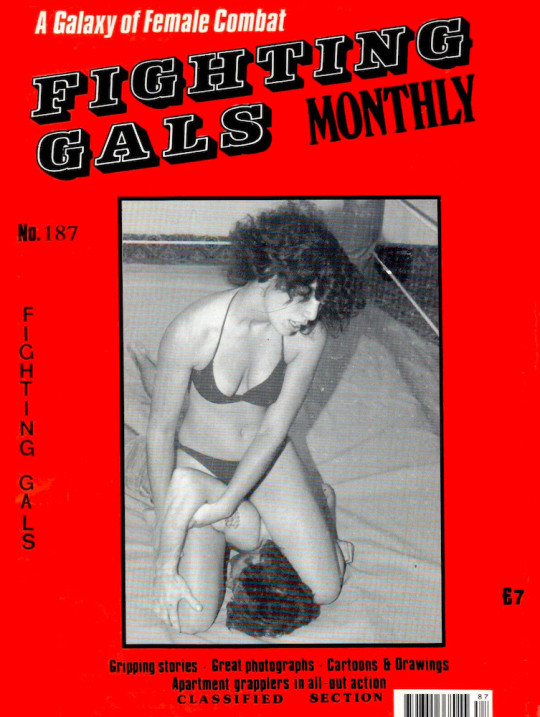
34 notes
·
View notes
Photo

Gregoire Alessandrini was only supposed to spend one year in New York. When the French film student and writer arrived in the early 1990s, however, he fell in love with the city. He would go on to spend eight "amazing" years in New York, working as a correspondent for different French magazines. He also photographed the city from 1991 to 1998. "At the time, I didn’t pretend to be a professional photographer, but I guess I had the intuition of being the witness of a vanishing world," Alessandrini told HuffPost. "Here and there, one could see the remains of a golden era, of a certain idea of New York. A mythical time, where one could stumble into Basquiat, Patti Smith or Debbie Harry at the corner deli. A period where everything seemed possible, cheap, simple and wild!" "The city had obviously tremendously changed since the 70’s and 80’s but you just had to walk around the corner, enter any downtown dive bar to find the signs and remains of this legendary NY. Just like if the city was waking up with a bad hangover from all the past parties and eccentricity. You could just point your camera and here you went… old Keith Haring murals, empty lots, graffiti and RIP murals, crazy people and wild parties, cinematic atmospheres in the desolate Meat Packing District, 42nd Street sleaze still alive, old signs and store fronts, 'old' New York atmosphere in general." These days, Alessandrini lives in Paris and occasionally visits New York. The city, of course, has changed dramatically since he left, particularly in downtown Manhattan where Alessandrini used to hang out. "Last September, I was literally shocked to see how much the Lower East Side (the 'bad boys playground' at the time) had changed," he wrote in an email. "In late 2012, I remember being dropped off by a yellow cab on Bowery and looking for Bowery! This sudden transformation of downtown Manhattan had started before the twin towers went down but it seems to have accelerated at an incredible pace." © 📸 @newyork1990s #GregoireAlessandrini #newyork1990s #Thestreetiswatching 🥳🔉 🍕🖕🏿 #Ⓚ #kittesencula #loved&posted 𝖉𝖗𝖆𝖌𝖔𝖕𝖚𝖇𝖑𝖎𝖘𝖍𝖊𝖗.𝖈𝖔𝖒 ᴋɪᴛᴛᴇsᴇɴᴄᴜʟᴀ.ᴄᴏᴍ (presso Broadway) https://www.instagram.com/p/CXgvXoBNpFm/?utm_medium=tumblr
7 notes
·
View notes
Text

Private N°44 - Brazilian Magazine - Jan. 1989
#private#brazil#brazilian#magazine#magazines#vintage#vintage photography#vintage sleaze#sleaze#vintage smut#smut#retro#retro aesthetic#80s#80s aesthetic#1989
10 notes
·
View notes
Photo

The only thing that truly interests me in a photo is the miracle. That something happened at that moment that can never happen again. And I’m astonished by those miracles.
- Frank Horvat
Frank Horvat, one of the founding fathers of French fashion photography died aged 92 on 22 Oct 2020.
He worked as a fashion photographer and photojournalist, and kicked off his career shooting the seedy underbelly of street life of Paris. His photograpghy covered a diversity of people and situations from a beggar in India in 1953, French strippers at the Sphinx club in 1956, subway commuters in New York City in the Eighties to intimate shots of life at his country house for a project he called La Véronique in 2003.
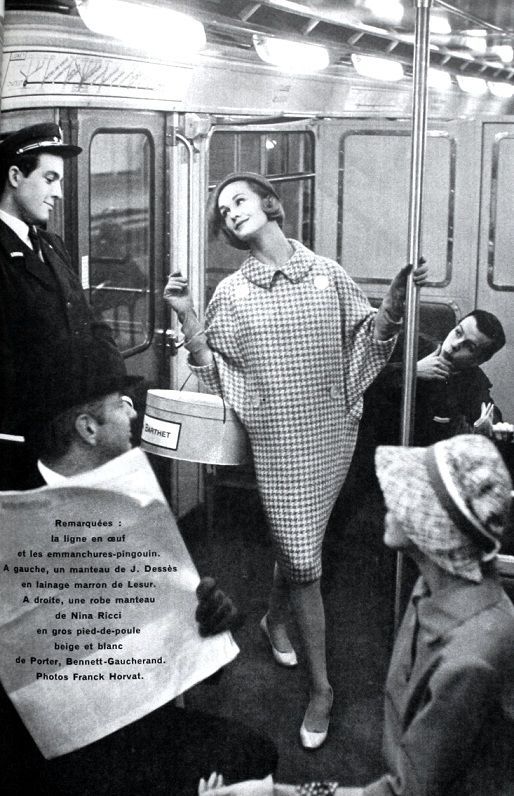
His reportage style, incorporating bustling street life into his shots of models and designers, helped shake up the genre and had a lasting effect on the fashion industry – even if this work disappointed his early mentor Henri Cartier-Bresson, who labelled it “pastiche”.
Born on April 28, 1928, in Abbazia, Italy — which is now called Opatija and is part of Croatia — Horvat acquired his first camera as a teenager, trading in a stamp collection for a 35mm Retinamat. After studying fine art at the Brera Academy in Milan, he made his first trip to Paris in 1950, where he met Henri Cartier-Bresson and Robert Capa.

A meeting in 1950 with Cartier-Bresson in Paris proved pivotal to his photographic career, encouraging him to adopt the Leica camera and take a two-year trip to India, during which he experienced his first success.


By the mid-1950s he had moved to Paris, working first as a photojournalist capturing the sleaze and squalor of the French capital, before turning to fashion photography, injecting what had become a staid genre with a similar dose of realism.
Horvat spent the late Fifties and early Sixties shuttling between Paris, New York and London. He was a Magnum photographer and worked for Life and Paris Match, and also shot fashion photos for Vogue, Elle and Harper’s Bazaar.
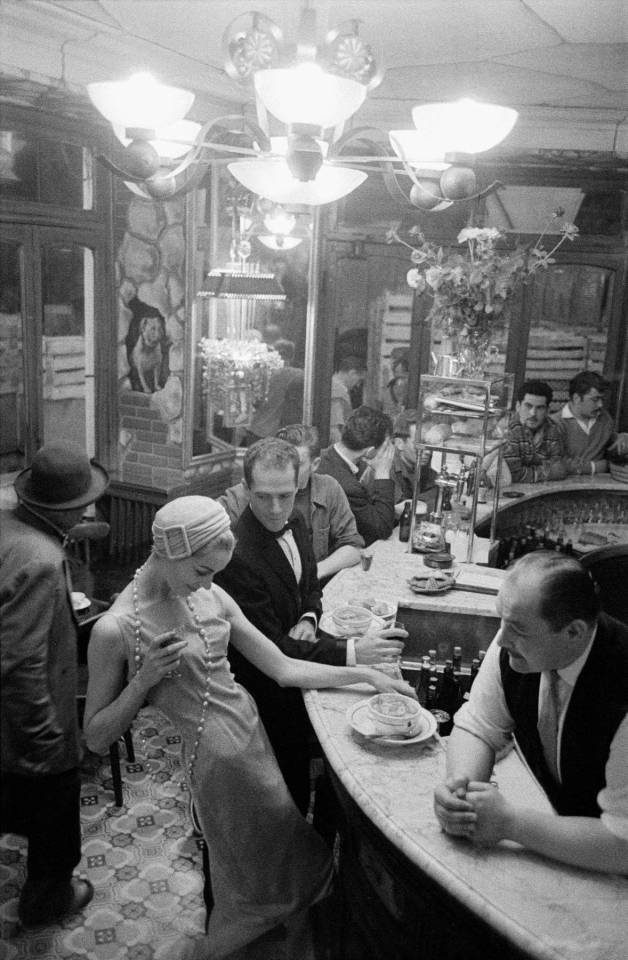
His reportage-style fashion shoots of top models and designers often included lively street life and have become classics.
He spent time in Asia, and was sent around the world for the German magazine Revue. When magazines began to disappear in the Seventies, he embarked on freelance projects.

Horvat’s later work included branching into colour photography with projects such as his 1980s series New York Up & Down, which saw him turn his lens on the city’s subway passengers and coffee shops. Horvat’s work became so varied it was difficult to pigeonhole, covering everything from trees to sculpture to his own home in Provence. When his eyesight started to fail in one eye during the mid-80s, he began interviewing other photographers he admired, such as Don McCullin and Sarah Moon.
Horvat embraced much of photography’s changes, including the advent of digital, social media and Photoshop, which he believed helped compensate for the loss of sight he had suffered. Horvat also set up an iPad app called Horvatland, and a Facebook page that he curated daily, uploading pairs of photos for his followers to interpret freely.

RIP Frank
66 notes
·
View notes
Text
BLOGTOBER 10/4/2020: SOCIETY
Without having a survey to back me up, I feel comfortable asserting that as a horror fan, you go through different phases with SOCIETY. It’s a basic fact of life, and yet it morphs and mutates underneath you, shocking you anew just when you think you’ve got a grip on it. You never forget your first time, because there is simply nothing like it. Then, after you get over the initial shock of its patented brand of body horror, you start to take it for granted; it's so broad and monolithic that it becomes something like the Grand Canyon--when it’s not right there in front of you, you begin to experience it more iconically, as part of the wallpaper of existence, rather than an in-your-face confrontation with the limits of experience. Then, you revisit it every few years (or months, depending on what sort of person you are), and the prophylactic layer that your brain has wrapped around your memories of it--the one that allows you to think of SOCIETY as a fun, wacky cheap thrill--begins to crumble, and you realize all over again how iconoclastically vile it is. Wherever you happen to be at, with this inimitable genre landmark, you'd be hard pressed to deny that it earns its royal status among horror movies, just for being so uniquely fucked up.
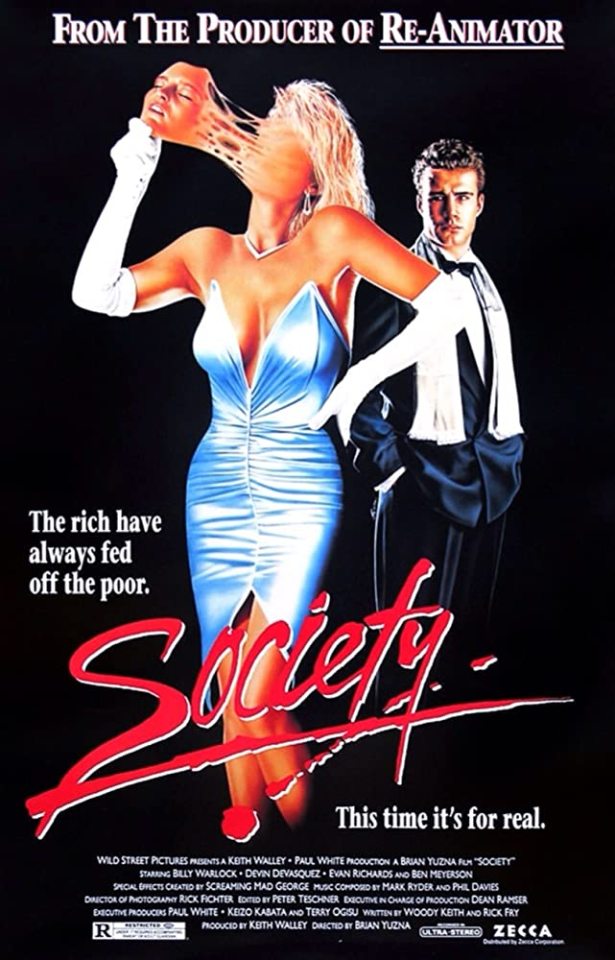
Filmmaker Brian Yuzna is best known as the co-creator of the indispensable RE-ANIMATOR (or as the co-writer of HONEY, I SHRUNK THE KIDS...depending on what sort of person you are, again), itself a milestone achievement in the blending of sex and gore that so characterized '80s horror production. That film clearly brought out the best in Yuzna and frequent collaborator Stuart Gordon (also of HONEY, I SHRUNK THE KIDS fame...among other things), but it's interesting to see how they operate apart, to understand the unique ingredients that each filmmaker brought to the more perfect union of their classic Lovecraft adaptation. Gordon skewed darker and more intellectual, as evidenced by the end of his career with the shattering mob thriller KING OF THE ANTS, the disturbing true crime drama STUCK, and the Mamet-penned EDMOND. Yuzna, for his part, is almost anti-intellectual, preferring to cook up blackly comic, semi-pornographic nightmares like his two increasingly horny RE-ANIMATOR sequels, the terminal S&M fantasy RETURN OF THE LIVING DEAD 3, and the shamelessly hokey comic book adaptation FAUST: LOVE OF THE DAMNED. Yuzna's lack of shame is really his defining feature as an artist, and nowhere is this more obvious than in his directorial debut and signature masterpiece, SOCIETY.
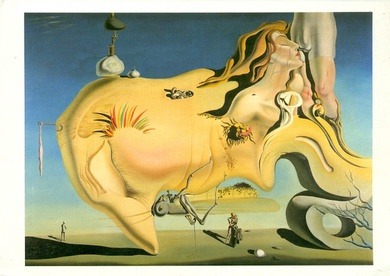
Salvador Dali's "The Great Masturbator," a chief visual inspiration for SOCIETY.
Yuzna was able to leverage the success of RE-ANIMATOR to lock in two directorial opportunities, BRIDE OF RE-ANIMATOR, and a bizarre body horror exercise about a Beverly Hills orphan who discovers that not only are his adoptive family from a different bloodline, but they're not even from the same species. That both pictures employed the writing team of Woody Keith and Rick Fry gives you a little taste of what to expect from SOCIETY, but to be frank, the latter threatens to make the former look like a very special episode of ER; "overkill" barely begins to describe SOCIETY’s ambitious assault on the human body. In a recent interview, the philipino-american director giggles perversely, "I think my friends were a little embarrassed for me (when they saw SOCIETY)," and this sound bite reminded me that the last, most important ingredient that Yuzna contributes to any project is unabashed joy. It's a little hard to imagine stomaching SOCIETY without it.
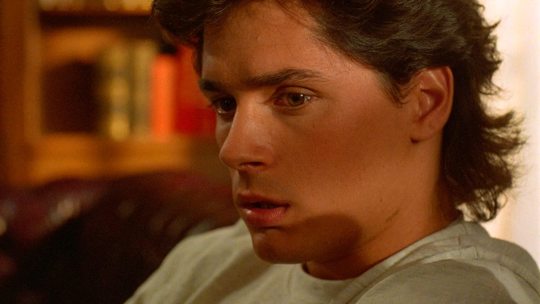
In this unusual scene from the class struggle in Beverly Hills, Billy Warlock (son of HALLOWEEN 2's Michael Myers, Dick Warlock) plays Bill Whitney, a rich, handsome, athletic high school student with a heavy duty anxiety disorder. Although he appears to have it all, he is plagued by nightmares and hallucinations, reflecting suspicions that the family that spoils him is also out to get him. Perhaps this is all understandable, though. Bill is under a lot of pressure these days, with his parents devoting all of their attention to his sister's coming out party, and his narcissistic girlfriend pushing him to ingratiate himself to the assholes higher up the social ladder; it's enough to make any teenager feel alienated and insecure. But, do these garden variety anxieties account for his visions of his sister's body deforming itself unnaturally, or the dubious evidence he finds that her debutante ball involves incestuous orgies and human sacrifice? Is Bill simply crumbling under the strain of societal expectations, or is the friction with his shrink, his parents, and his peers all symptomatic of an elaborate plot against him by elites who are truly less than human?
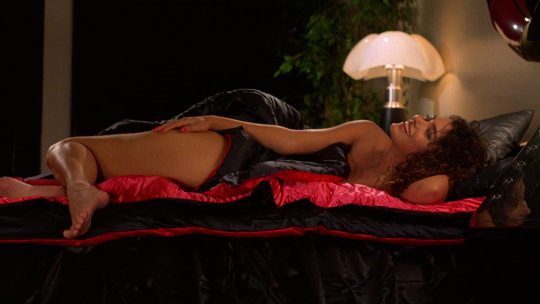
I can’t believe they use this cheapo blanket trick MORE THAN ONCE in a movie that is famous for its unforgettable special effects, and I guess I kind of love it.
In case I haven't made the answer abundantly obvious, I'll add that while SOCIETY is the purest expression of Yuzna-ness on the market, it has an important co-author in Screaming Mad George. The eccentric japanese FX master, whose name is apparently an amalgamation of Mad Magazine, Screamin' Jay Hawkins, and...George, has produced some of horror's most outrageous makeup and visual effects, mostly for Yuzna, many of them in SOCIETY. If you've seen even a trailer for Alex Winter's 1993 oddity FREAKED--which is itself a grossout criticism of American social standards--then you are already familiar with SMG's trademark style. He specializes in twisted perversions of the human form that would make a cenobite blush, driven by a penchant for puns, and influenced equally by THE THING's Rob Botin, and Big Daddy Roth’s Rat Fink style. Screaming Mad George is instrumental in articulating Yuzna's premise: that behind the shimmering veneer of success and sophistication, the upper class are just a bunch of degenerates, who literally degenerate into something unimaginable behind closed doors. It's impossible to imagine SOCIETY without his sinuous, slithering monstrosities, or his indescribable realization of their most important social event, "the shunt".
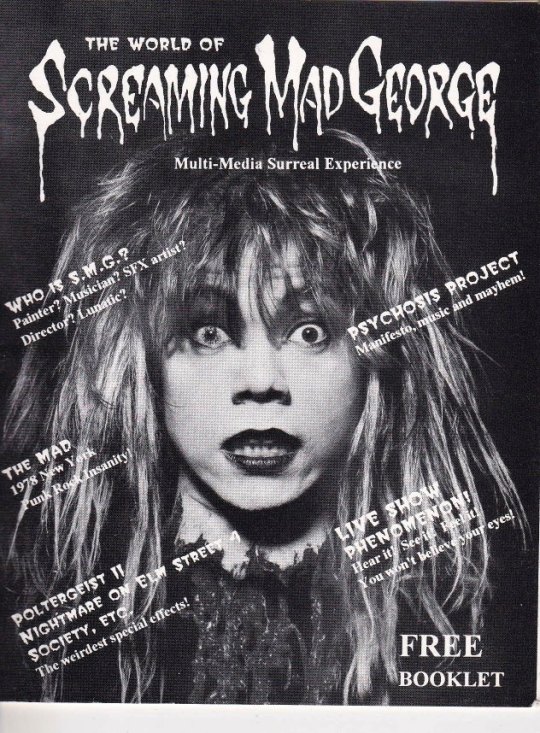
One of many great images from a zine I wish I owned, on SMG’s Facebook page.
It's easy to get overwhelmed by SOCIETY's visual impact, but its message is just as potent now as it was at the end of the Reagan era: Rich people are not only different from the rest of us, but in fact, they aren't even human. Writers Keith and Fry make an interesting choice of hero to help put this across. A lazier writer would have selected any archetype from the Freaks and Geeks set to create an easy Us vs Them tension, but SOCIETY is led by a promising young man who, for reasons he himself does not yet understand, is just not "the right kind of people". Bill appears to have every advantage in life, including a level of popularity that wins him presidency of the debate team despite his nerdier rival’s superior prowess--and yet, he suffers from a stigmatizing psychiatric disorder that is the natural result of feeling indefinably different from one's peers, and intuiting that, as a consequence, they don't even really like you. The shallow jock with deep-seated emotional problems is a much more interesting protagonist for this kind of social allegory than the charismatic outcasts that you get in movies like THE FACULTY and DISTURBING BEHAVIOR, for whom the idea that the elites could be aliens is just de rigueur.

It's worth noting that this complexity of character extends to Bill's love interest, sympathetic society girl Clarissa Carlyn (Playboy Playmate Devin DeVasquez). At first, she seems villainously eager to introduce Bill to the many splendors of "the shunting", but as the plot against him mounts to its horrifying conclusion, she defects. There appears to be a reason for this, although honestly, this is the most difficult part of SOCIETY for me to wrap my head around. Clarissa lives as an essentially independent adult, only burdened by her mother (Pamela Matheson), a possibly brain damaged hulk who lurks in and out of various scenes just to be disturbing, always announced by some toots on a tuba, before eventually siding with our heroes. I'm really not sure what's supposed to be going on in this part of the movie, except that this character contributes to a number of distasteful jokes. But, I hold on to the idea that by virtue of whatever disorder Mrs. Carlyn suffers from, she serves the purpose of priming Clarissa to rebel, since her very existence makes her daughter something of a societal outcast herself. That's the best I can do.

In any case, everyone working on SOCIETY commits completely, with Mrs. Carlyn being no exception. The movie's climactic orgy of the damned is an all hands on deck operation, just as reliant on Screaming Mad George's artistic abilities as it is on the actors' responsibility to make you believe that this fucked up shit is really happening. There's a visceral patina of sleaze spread over the entire film, dripping from the way that characters talk to and touch each other, flirting and flaunting their bodies in a distinctly unseemly fashion, even when it stays within the realm of mundane reality. This constant sinister, insinuating attitude on the part of the whole cast lays the foundation for what is to come, and while I appreciate everybody's hard work, my favorite performance is from an actor who only comes in at the very end: David Wiley as society king Judge Carter. Wiley's career consisted almost exclusively of the most ordinary sort of television work, which makes his outrageous turn in this alien porno flick all the more respectable. While other characters transition from suspicious pod people to full-on mutated perverts, Judge Carter has to show up just for the finale, establish his authority, rip off his clothes, and plunge straight into a sea of slime, happily fisting his way through the cast. Wiley meets this challenge with aplomb, making of himself a hybrid of Robert Englund and Gene Hackman, perfectly embodying the movie's joyful absurdity, and never betraying the slightest hint of embarrassment.

SOCIETY is very much a don't-look-down type of endeavor, a fairy that could expire at the slightest lapse in faith. There's a visual pun in the last act that's so gross, so offensive, so frankly idiotic, that I don't have the courage to describe it; my whole body tenses up when I know this scene is coming, as if it were the meat hook scene in TEXAS CHAIN SAW MASSACRE or the brutal rape in the middle of SHOWGIRLS. I don't like it, but at the same time, I respect Yuzna's unhesitating commitment to show it to me, and I think that actor Charles Lucia should get some kind of award for shouldering the burden so valiantly. SOCIETY is a daring movie in the truest sense, a film with more balls than brains, and in this it exposes the limitation of intelligence and taste, and the real need for pure transgression, in producing art of any real value. You might argue with me about whether Yuzna's masturbatory magnum opus really qualifies as art, but to respond to that, I'll quote the great transgressor Alejandro Jodorowsky: "If you are great, EL TOPO is a great picture. If you are limited, EL TOPO is limited." So stick that in your shunt and smoke it.
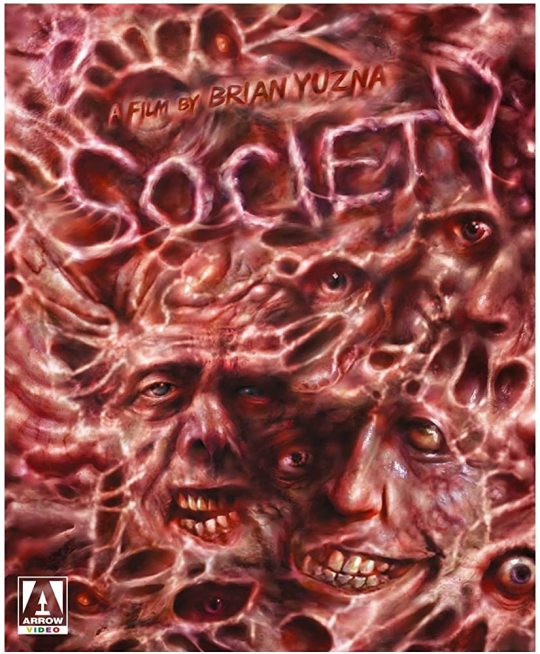
undefined
youtube
PS Here, have this stuck in your head for the rest of your life.
#blogtober#2020#society#brian yuzna#screaming mad george#woody keith#rick fry#billy warlock#Keith Walley#devin devasquez#david wiley#horror#black comedy#satire#body horror#social criticism
27 notes
·
View notes
Text
Nixon at 25
Oliver Stone’s Nixon, the oft-controversial director’s look at the life of the 37th president of the United States, his rise and his downfall, came out a little more than 20 years after Nixon’s resignation from office (and less than two years after his death.) More time passed since the movie than the amount of time between its events and the movie, and it’s the equivalent of a movie being made today about the Clinton impeachment, or the Bush/Gore election.
Many reviewers compared it to Shakespeare’s plays about medieval kings, the difference, of course, being that only a couple of decades had passed since Nixon’s time. There were comparisons to Citizen Kane as well.
The film, at 192 minutes, was one of several in the fall and winter of 1995 that went well past the three-hour mark, and while it wasn’t nearly as exciting as Michael Mann’s Heat, which arrived the week before, Nixon had a lot to offer for political junkies, as well as those who remember that era well- especially those who despise Nixon.
In usual Stone fashion, the film included an attempt to psychoanalyze Nixon, albeit not in a way that differed particularly from the conventional wisdom about the man. He came from relatively humble and often tragic beginnings, and had a seething resentment of the Kennedys and others from a more elite background than himself. Nixon would use that resentment as a sort of oxygen for his political career, which helped him get elected president in 1968 by harnessing the “silent majority” of the cultural backlash against hippies and protesters. It’s a playbook that’s been executed various times in the years since, most recently by Donald Trump.
Stone’s film follows the ups and downs of Nixon’s political career, including his loss to Kennedy in 1960, his failed run for governor of California two years later, and his ultimate comeback in getting elected president. There’s also many depictions of Watergate, including Nixon committed the crimes that nearly got him impeached before his resignation. The film also depicts Nixon as a surly drunk, who had a terrible relationship with his long-suffering wife Pat (Joan Allen.)
Part of the fun of Nixon was the casting of great actors in all of the roles of major Nixon Administration and Watergate figures. There was James Woods, bringing the sleaze (and the anti-Semitism) to the role of H.R. Haldeman, J.T. Walsh as John Ehrlichman, Powers Boothe as Alexander Haig, Paul Sorvino as Henry Kissinger, Ed Harris as Howard Hunt, Bob Hoskins as J. Edgar Hoover, and a dozen more. Dan Hedaya- who would play Nixon himself four years later in Dick – played a character based on Nixon’s friend Bebe Rebozo. Larry Hagman even popped up in a memorable scene as a Texan power broker meant as a stand-in for the John Birch Society.
It was Anthony Hopkins, just a few years off his Oscar win for The Silence of the Lambs, who played Nixon himself. And perhaps the most controversial decision at the time was to have Hopkins portray Nixon without any facial prosthetics, and not particularly making much of an attempt to look or really sound anything like Nixon. This never particularly bothered me, although I wasn’t born until four years after Nixon left office. Hopkins, now in his 80s, is still at it, nominated for an Oscar last year for The Two Popes and looking at another one this year for his fine work in The Father.
While the film isn’t nearly as untethered from reality as Stone’s J.F.K. was, there’s a lot in Nixon that’s a bit historically creative. Nixon, for instance, probably didn’t really speak to presidential portraits at night, and there’s no indication he really did say to the Kennedy portrait, “when they look at you, they see what they want to be; when they look at me, they see what they are.”
There’s the implication that Nixon had approved anti-Castro operations as vice president that led to the Kennedy Assassination, in one of the film’s more far-fetched conceits, and there’s also discussion of a concept of CIA/government malfeasance that Nixon calls “The Beast,” which sounds a lot like the Trump-era concept of “The Deep State.” The extent of Nixon’s alcoholism, meanwhile, has been debated by historians.
The Richard Nixon Library put out a statement at the time denouncing the film, although I’m not sure I’d want to see a Nixon movie that the Nixon library would approve of.
No, it’s not the best film about Nixon or Watergate. That honor goes to All the President’s Men, a film in which Nixon didn’t actually appear as a character. There’s also the wonderful satire, Dick, from 1999, and Secret Honor, The Post, Frost/Nixon, and even various documentaries. Rick Perlstein’s book Nixonland, from 2008, remains popular culture’s most incisive examination of the Nixon era, but it wasn’t particularly about Nixon himself and wasn’t exactly the sort of thing that could easily adapt to the screen.
Will we get this type of movie examination of the Trump era? That feels inevitable, and it’s already started to happen, with the Showtime miniseries The Comey Rule. I’m sure we’ll one day get something like Nixon, a more than a three-hour examination of Donald Trump’s life and presidency, with Great American Actors in all the main roles.
However, it probably won’t come from Oliver Stone. The director is now far from his peak, and no longer making films that take over the cultural conversation. His film about George W. Bush, W, added nothing to the popular understanding of that president, and his 2016 Edward Snowden biopic was redundant, coming just a couple of years after the same story was told in the documentary Citizenfour (Snowden did become an unlikely Netflix hit this year, however.) Stone has also made embarrassingly fawning documentaries about the likes of Fidel Castro and Vladimir Putin, and while his Wall Street sequel a decade ago, Money Never Sleeps, was entertaining, it didn’t really need to be made.
Nixon isn’t quite at the level of JFK, or some of the other films in Stone’s golden era in the ’80s and early ’90s. It is, though, a fine but flawed portrayal of a very flawed man.
-Stephen Silver, “Revisiting Nixon,” Tilt magazine, Dec 22 2020 [x]
2 notes
·
View notes
Text
tagged by @mendelpalace in one of those 21 questions gimmicks so hell, why not?
Nickname: hot jughead
Zodiac Sign: aquarius
Height: 6′
Hogwarts House: whichever is least lame
Last Thing Googled: “barfly 1987″
Favorite Musicians: ryuichi sakamoto, three 6 mafia, slayer, prefab sprout
Song Stuck in My Head: sheila e. - “the glamorous life”
Following: 292
Followers: 691
Amount of 💤: fuck all, like 2-5hrs a night.
Lucky Numbers: 77
Wearing: an ancient venture bros. t-shirt club shirt (the “spanakopita!” one) & olive drab slacks
Dream Job: trophy wife
Instruments: guitar & bass but haven’t touched either in years, recently been teaching myself how 2 use modular synths
Favorite Songs: fuck i dunno, a lot, but recently like, all of side A of kate bush - never for ever has been hittin’ good
Random Facts: i had a rly rly brief phase as a theatre kid, only was ever in two plays (some stupid fantasy pastiche thing & dracula) but i won awards for both; the ankles on both feet are totally fucked craggy messes of bone cuz i managed 2 break both at the same time falling down a hill as a kid & the fuckers never rly healed right; i can read french fluently but if you spoke it 2 me & expected me 2 be able 2 speak back unless we’re at a fuckin’ restaurant y’r getting a shrug & a laugh
Aesthetics: hot dogs, hot broads, hot cum, low-tech cyberpunk, late 80s sleaze, candy packaging, 90s magazine layouts
3 notes
·
View notes
Text
So, anyway...
Costello Presley. i recently complimented a fellow Tumblr’s latest tune comparing it favorably to “Costello Presley”. Who is Costello Presley? you may ask and i’ll gladly repeat. He’s been featured on blueguitar previously but it’s not like you can search my Tumblr easily anymore since i was labeled ADULT and hidden from regular view. “Costello Presley” is the nom du porn of an electronic musician best known for scoring the gay pornographic films of William Higgins. His actual name is unknown. According to the one interview he did for InTouch magazine (?), his dayjob was in advertising. No doubt scoring BubbleYum TV commercials in my mind. Not sure what ultimately attracts me to his music except that it has an 80′s gleam but with a hint of hard-core sleaze darkening the edges that has a certain appeal to it even or especially minus the guy-on-guy sucking and fucking visuals. He’s hard to find examples of on the web anymore. The films he scored are owned by Catalina Films, if that company hasn’t changed hands yet again. Costello Presley himself hasn’t resurfaced in anyway i am aware of, though his need for anonymity certainly can’t be so necessary anymore. i recently posted a song called “Mimosa” by a Costello Presley who most certainly is not. But savvy enough to know his repute made for a great DJ moniker. But these two are the real deal. “Animal Reaction” by Parralox and “They Lied To Me” by Jimmy Michaels are remixes of the real thing. How these came to be is unknown to me. But, PLEASE ENJOY!!!
youtube
youtube
0 notes